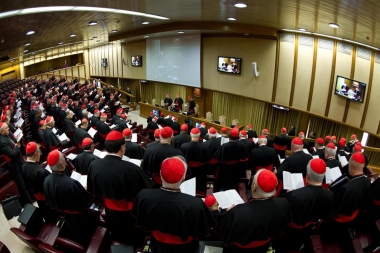The Young

INTERVENTION of S. EM. CARD. RAVASI
(Part I - chapter II – Nos. 26-35)
Synod of Bishops 2018
I would briefly emphasize Nos. 26-35 of the Instrumentum Laboris, a section that looks at contemporary youth culture. It is estimated that there are currently 1.8 billion people in the world between 16 and 29 years old, a quarter of humanity. Pope Paul VI said: “Many today speak about young people, but not many speak to young people.”
1. When we talk about young people, however, we can still identify what they themselves communicate in their very many different ways of thinking and acting. There are two opposing facets to explore.
The first includes many problematic features that often mirror the new ethical-social models. I am thinking of the phenomenon of the fragmented self, linked to the primacy of emotions, and of the linear accumulation of things rather than the quest for further understanding. Thus, the anorexia of the projects and goals corresponds to a bulimia of resources – especially information technology. The dominance of technology over humanistic knowledge is also significant. And then I think of the ethical and religious apathy and also of a certain juvenile tendency to self-reference that oscillates between the mentality of being part of the herd and the rejection of the other, as seen in bullying or in verbal and pictorial violence on the social networks.
There is, however, a second very positive facet: young people are bearers of great human and spiritual resources. Suffice it to mention the strong sense of friendship, lived solidarity, voluntary service, yearning for freedom, authentic witness, love for music, the arts and sport, request for coherence addressed to the civil and religious community, the call for a more joyful and evangelical Church, the fascination still exercised by the figure of Christ and his Gospel.
2. Finally, a word on the ability to speak to young people. The Church needs to delve into a new language that is in harmony with young people’s new communicative grammars, taking into account the horizons that are of interest to them. I’ll briefly mention two:
The first is that of science and technology, which are rewriting much of classical anthropology. Young people are fascinated by them: think only of genetics and DNA, its flexibility and how it can be modified, or the neurosciences and their many ethical implications, or Strong Artificial Intelligence, which sees machines becoming self-aware and able to “think.”
The second horizon is the prevailing path of digital culture, that is, of the infosphere whose web embraces the whole of humanity, including, in a radical way, the young people, the digital natives. The realm of the virtual, the multiplication of data, homogeneity of languages, accelerated communication, incessant enjoyment – making some people info-obese – are risky components, as is seen in the violence, pornography, the “dark web,” and falsity in the network. But this digital culture is needed to weave new dialogues, to transmit values, and to integrate the Christian message in this new global Areopagus.
To conclude, we recall the words of another holy Pope, John XXIII: “Tell the young people that the world already existed before them, and remind the elderly that the world will exist after them.”
(This is the written text used by Cardinal Ravasi as a basis for his off-the-cuff remarks at #Synod2018)



